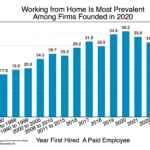Leadership Failures, Not Remote or Hybrid Work, Create Disengaged Workers
Once again, leadership “experts” look at dismal employee engagement percentages. Once again, they conclude that remote work or hybrid work is to blame.
According to The Wall Street Journal, more people who work from home feel disconnected to the mission of their employers. The Gallup survey cited shows people who work from home have a problem connecting with their jobs, and the article makes the case that the issue is remote work.
The whole thing just makes me want to scream No! No! No!
The issue is a lack of Insightful Leadership. Leaders fail to communicate a clear vision, a compelling vision and shared value. Therefore, leaders fail to inspire their workforce to pull in the same direction. Leaders fail to trust their employees to get the job done.
No #1: For Employee Engagement, Work-life Balance is the Key
Do you really think your employees will feel more engaged if they sit in traffic for lengthy commutes? Will they help achieve your company’s goals by being more disconnected from their marriage, from parenting, from their life?
No!
Like it or not, for most employees, life is about being connected to life. Not your company. To have happy, productive, employees, you need to look at work/life balance. That will move your culture toward one that supports well-adjusted, productive employees.
No #2: Disconnected from Work Scores Rise Across All Categories
Do you think it matters to the disengaged employee whether they are in the office or not?
No!
This is where you must go beyond the headlines. Examine the numbers in the Gallup poll cited by The Wall Street Journal:
- In 2019, 43% of hybrid workers said they felt connected. That has dropped to 35%
- In 2019, 38% of on-site workers said they felt connected. That has dropped to 33%
- In 2019, 36% of exclusively remote workers said they felt connected. That has dropped to 28%
In every single category, worker engagement has declined (8%, 5% and 7%). All are below 40%.
The difference is not where you work. The difference is how the post-pandemic world has disconnected people and institutions no matter where they are.
We have a big problem.
No #3. What Causes Employee Disengagement? Leadership Failure
In several of my leadership books, I have written that leaders must have a clear vision, mission and guiding principles. Insightful leadership communicates these value and measures of success to their workforce.
This is what leadership experts are calling “connection.” And the bottom line is that leaders are failing at their core responsiblity.
An employee base with exceptional work-life balance will respond to this message. An employee base you order around will not. Top-down, command-and-control leadership is out. Trust and inspire, per Stephen M.R. Covey, is in.
A Big Yes to the Smucker’s Employee Engagement Model
J.M. Smucker wants its employees at Ohio headquarters for 22 “core weeks” a year. In return, workers can live anywhere. Yes, they have to pay their way back to Ohio for their core weeks. But for many, that give is worth what they get from their employer: Work-life balance.
The Wall Street Journal story on J.M. Smucker detailed how the company debated this strategy for months.
As Chief People Office Jill Penrose told The Wall Street Journal: “Every company was dealing with employees for two years who had been performing quite well working remotely.”
The story made three important points:
- Their policy is unusual, but it is working.
- The policy is not a one-size-fits-all straitjacket. The policy depends upon employee roles – optionality.
- The key is having employees come together during the “core” weeks. This drives and enables collaboration.
This is clearly not about command and control. It is about balancing the needs of your workers with your corporate goals. It is about inspiring your workers with clear goals. It is about trusting your workers to accomplish these goals.
Look, I cannot tell you how many core weeks your organization needs. Not everyone is a remote work junkie like me who looks forward to hours of Zoom calls.
Employees at my companies, Tompkins Ventures and Tompkins Leadership, have been in the same room for all of two days in three years. You might need 10 core weeks. You might need 25.
Figure it out, hire the best people regardless of geography, and adjust to make it work.
Looking for some help navigating ways to reinvent work? I would to discuss your organization’s leadership goals and find a path for your success.
Jim Tompkins, Chairman of Tompkins Ventures, is an international authority on designing and implementing end-to-end supply chains. Over five decades, he has designed countless industrial facilities and supply chain solutions, enhancing the growth of numerous companies. He previously built Tompkins International from a backyard startup into an international consulting and implementation firm. Jim earned his B.S., M.S. and Ph.D. in Industrial Engineering from Purdue University.






